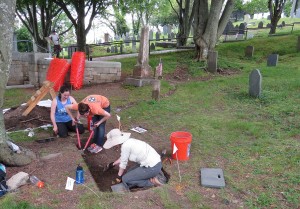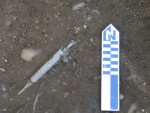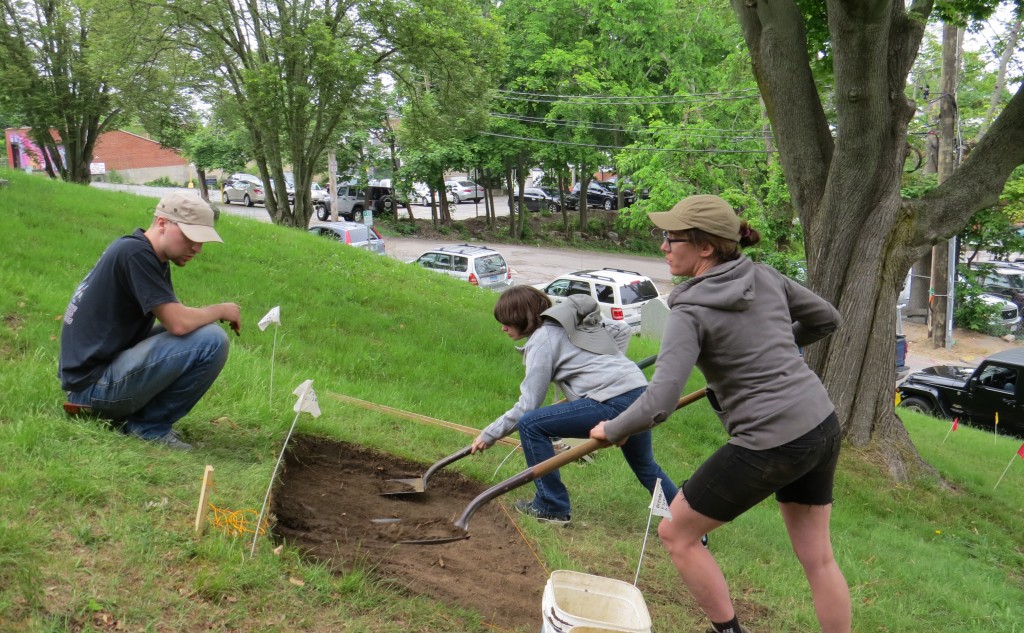By Anna Crona
As our first full week of field work comes to a close and our second week is about to begin, there is a lot to reflect upon and even more for which to prepare. At the beginning of the week we had three units opened at both of our sites in downtown Plymouth. We started with three 2 meter x 1 meter units located at Cole’s Hill and two 2 meter x 1 meter units and a 2 meter x 2 meter unit located at Burial Hill. On Burial Hill, we soon added two additional 1 x 2 meter units. Our crew has collectively been hard at work moving and sifting through tons of soil, with the goal of uncovering undiscovered, crucial information about the original Plymouth settlement and the people involved in its genesis. Both sites have found intriguing artifacts and features and the students involved are being thoroughly trained in archaeological methods and protocol. The professors and teachers’ assistants are demonstrating the compassion, care, and attention to detail necessary to make archaeology a thriving and useful tool for historical research.

Caroline, Anna, and Samantha work on one of the units on Burial Hill.
At the end of the week, the Burial Hill archaeologists left off having entirely closed out one unit. This unit was closed because its team was encountering several centimeters of sterile sand, about 55 centimeters from ground level. Additionally, two more units were opened: one directly behind the town tomb structure and the other attached to the 2m x 2m unit. The latter was expanded because, about 60 centimeters down from the ground level, the team working in this unit discovered several areas of differently colored soil. These areas suggest that the team was unearthing what are likely seventeenth-century features. As a result, excavation on this unit was temporarily halted and the new, adjoining unit has been opened up with the hope that it will expose enough of the features to help us understand their shape and orientation.

Glass syringe in situ at the Cole’s Hill site.
A large part of this project incorporates an element of public involvement and interaction. Among the many questions visitors ask us is the inquiry, “Why do you dig?” We tell them, in a nutshell, that we are digging to find parts of the original Pilgrim settlement and possibly the palisade wall that surrounded the original town. On a deeper level, we dig to give a voice to the people who no longer have one. While working in Plymouth we are in the business of giving a voice to the colonists and the Native tribes that came before us. The colonists came here looking for freedom to live according to their beliefs and to find new opportunities that they did not have in the Old World. Unfortunately, while seeking a life of opportunity, they also took this same freedom from many others, in Plymouth from the Native Wampanoag who had lived in this area for generations. We continue to dig because it is more important than ever to tell the stories of the people, from all nations and walks of life, whose voices are not being heard. At a glance, archaeology gives us a different way to view history. Under the surface, archaeology gives us a different and more personal way to view and understand humanity. We dig to bring this view to light.
About the author:
Hello! My name is Anna Crona and I am enrolled in the 2016 UMass Boston archaeological field school in Plymouth. I am a recent graduate of Fort Lewis College in Durango, Colorado, where I received my bachelors degree in anthropology in December, 2015. During my time as an undergrad student, I focused my energies on historical archaeology and bioarchaeology, and more specifically, archaeology of colonial North America. Because of this, I am thrilled to be involved in the Plymouth excavations through UMass.


March 19, 2017 at 1:53 PM
Hi Anna,
I found your blog searching for info about recent discoveries on site. I also attended Fort Lewis in the mid 1970’s! (Is House of Pies still there?)
I had dreams of being an archeologist/journalist. I did the later but still love the former. Lol.
Good luck!
Cateland White
Las Vegas, NV